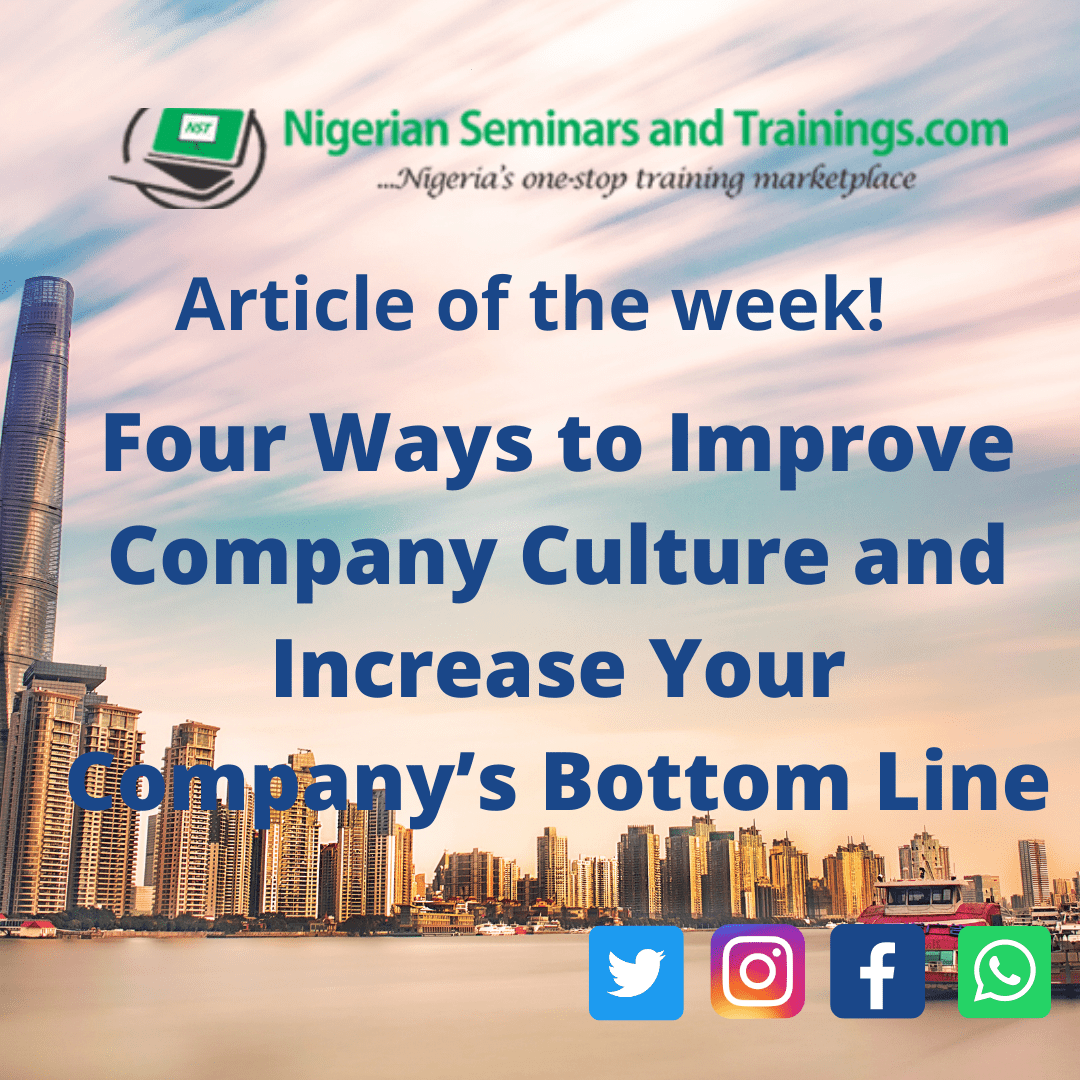As much as we emphasize the impact of leadership in running an organization, many are yet to fully understand and appreciate its vital role in the success or failure of an organization. A typical organization is essentially its people and not necessarily the material and financial resources it has. Therefore, providing effective leadership for the people that work in an organization is key to achieving its corporate goals and objectives. Being a good manager is a desirable quality that is necessary for putting the organization’s resources (including human, financial and material resources) to efficient use but managing people requires much more than managerial skills.
Competence in Leadership Is Even More Important.
In his book, “Good to Great”, Jim Collins shares the results of a four-decade research into the reasons why some companies become great and others do not. Over 1400 companies were studied in that period and only a handful of them (eleven firms) were found to have undeniably made the transition from good to great. Jim Collins identified three major qualities (in a continuum) of these great organizations and the very first is disciplined people (which precedes the other two, disciplined thought and disciplined action). The book helps us appreciates the vital importance of finding and deploying the right leaders at various levels within the organization.
The principle to be learned here is - first who, then what. We should first ensure that we have got leaders with the required level of diligence and competence before we set out to formulate and execute our plans or work towards achieving collective goals and objectives. When set goals are not being achieved especially on a consistent basis, look no further than the roles and activities of those in leadership positions. Think about this assertion for a moment - bottlenecks are usually at the top of the bottle. The earlier you realize this truth and act on it, the better for your organization.
Everything Rises and Falls on Leadership
A world-renowned expert on leadership, John Maxwell, couldn't have put it in a better way when he said, "everything rises and falls on leadership." Leadership is usually at the center of everything else, whether good or bad. When things go wrong, leaders should be the first to receive the blame and when they things work out, they should also be the first to receive the praise. Looking at a typical organogram may reveal that leaders are those appear to be at the top of the chart but in reality, they are at the base of any notable progress and advancement within the group or organization.
Often, organizations tend to look on the outside when things are going wrong and begin to conduct all kinds of analysis into their markets, customers, industry, competition, regulation and some other components of their external business environment. They may not realize that the root causes of these problems may hide beneath the surface and without an introspective examination, many of them may not be revealed. Even when the organization looks inwards, greater emphasis should be placed on its people (leadership in particular) and not necessarily its processes, policies and structures. Ironically, the problem becomes even more compounded when the human sources (leaders) of the problems are the ones trying to find workable solutions. It is very unlikely that such solutions would be effective except those at the helms of affairs are willing to swallow the bitter pill of self-criticism and make the necessary adjustments or leader-shift.
In periods of corporate distress and poor organizational performance, downsizing is often considered an easy way out of the mess and the organization rids itself of regular employees on the factory floor without remorse. From a pragmatic perspective, an organization should not undergo any major rationalization or re-engineering without purging its leadership ranks. That is where real and effective change is initiated before it spreads to the rest of the organization.
The Effect of Peter's Principle
For several decades, management scholars and experts have been astounded by the inevitable impact that Peter's Principle has had on many leaders both in business and non-business organizations. The principle posits that people tend to be promoted to a level or rank that may eventually expose their incompetence. By implication, they may lack the requisite abilities and attributes to function at the new level. Since the book of the same name was published in 1969 by Laurence J. Peter and Raymond Hull, some organizations who now appreciate its effect are still trying to find effective ways to nip it in the bud.
When the Peter's Principle sets in, it often happens in a subtle manner and may be quite difficult for the leader (and even his/her organization) to spot. And to make matters worse, subordinates then become the scapegoats as a treacherous means to excuse the incompetence of those in charge. When making an inquiry into a situation of this nature, anonymity may help to protect the identity of those who are willing to point accusing fingers at those at the top as the root causes of the problems (except in cases where a few courageous individuals are willing to speak out not minding the consequences).
The Effect of Dilbert's Principle
Another principle whose effect can be observed in the modern workplace is the Dilbert's Principle. This principle establishes the viewpoint that less competent people are usually promoted to managerial positions (where they are required to supervise and lead others) to minimize the extent of damage they can do to work activities. So, they are therefore expected to give instructions and receive reports without doing the actual work. Unlike Peter's Principle that states that people are promoted (because they are competent) to levels where they become incompetent, Dilbert's Principle says people are promoted because they are incompetent (and expected to manage competent people).
Even though they are quite different in proposition, a common thread stills run through both - incompetent people may occupy managerial and leadership positions in an organization. This is exactly where the challenge lies for the modern organization which must ensure that leaders remain relevant and maintain the required level of competence needed to excel on the job. When the leaders in an organization’s hierarchy begin to see themselves as sacred cows and untouchables that cannot be replaced or removed regardless of their performance, then such an organization is a disaster waiting to happen.
The Role of Level 5 Leadership
Jim Collins's study also found out great organizations usually have the level 5 type of leader in key positions. His book highlights five types or levels of leaders:
- Level 1: Highly capable individual who is someone with the right skill sets and experience to perform excellently on the job
- Level 2: Contributing team member who can interact and work with other members of a team towards achieving set targets
- Level 3: Competent manager who has the capacity to manage resources and organize his/her team for achieving set goals
- Level 4: Effective leader who can build a compelling vision and propel his/her team in the right direction for realizing that vision
- Level 5: Executive leader who possesses the abilities described in the previous four levels in addition to being inspiring and strong-willed.
Organizations, whether in the private, public or not-for-profit sectors, that desire growth and advancement must find and nurture level 5 kind of leaders. Such leaders can be said to have successfully made a leader-shift in their mindset and approach to the way they lead for the benefit of their organizations.
Level 5 leaders:
- Share the praise when things go right and are happy to take the blame when they don't Pursue ambition not for personal gains but for the benefit of the entire team or group.
- Groom others to succeed them and feel comfortable when their successors outshine them.
- Do not make attempt to assume larger than life personalities and like working behind the scenes
At this juncture, you need to ask yourself some pertinent questions namely:
- What kind of a leader am I in my organization and,
- Am I willing to make the leader-shift that is necessary to produce the right results?
Have questions, suggestions, opinions on the topic? Jump in by writing in the comments box below.
Related Articles

|
Viewing Your Job from the Right PerspectiveIn today's world of work, many employees have developed a needless proclivity for job-hopping rather than finding and improving themselves on a stable job. The situation is far worse in organisations that do not provide a conducive work environment for their human resources. But is frequent job- [Read more]
|
Posted: 4 years ago |

|
A Closer Look at Nigeria’s Economic PerformanceUncertain Performance - Just how well is the Nigerian Economy performing? In the absence of a holistic report articulating the economic performance of Nigeria, no one could claim to know. There are only a lot of partial views on different aspects of the economy being expressed by different governmen [Read more]
|
Posted: 13 years ago |

|
Four Ways to Improve Company Culture and Increase Your Company’s Bottom LineThere are a few things to always pay close attention to in a company, like your employees’ salaries, morale in the office, understanding of vision and many more. But one aspect of your company’s daily activities that need to be reinforced constantly is the company culture. This is b [Read more]
|
Posted: 7 years ago |



